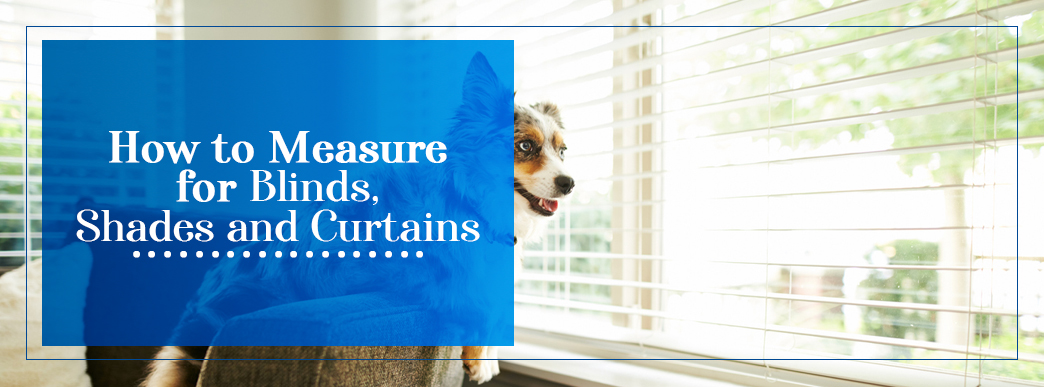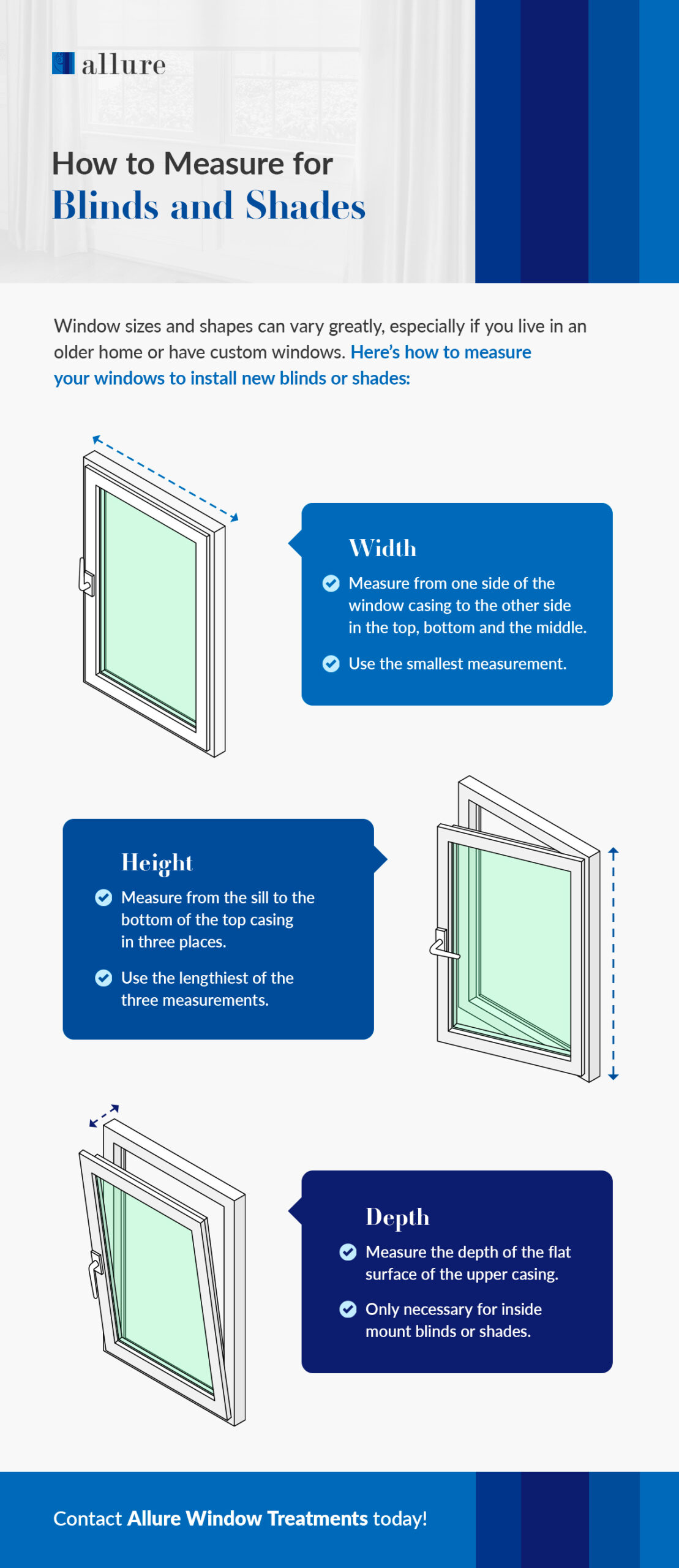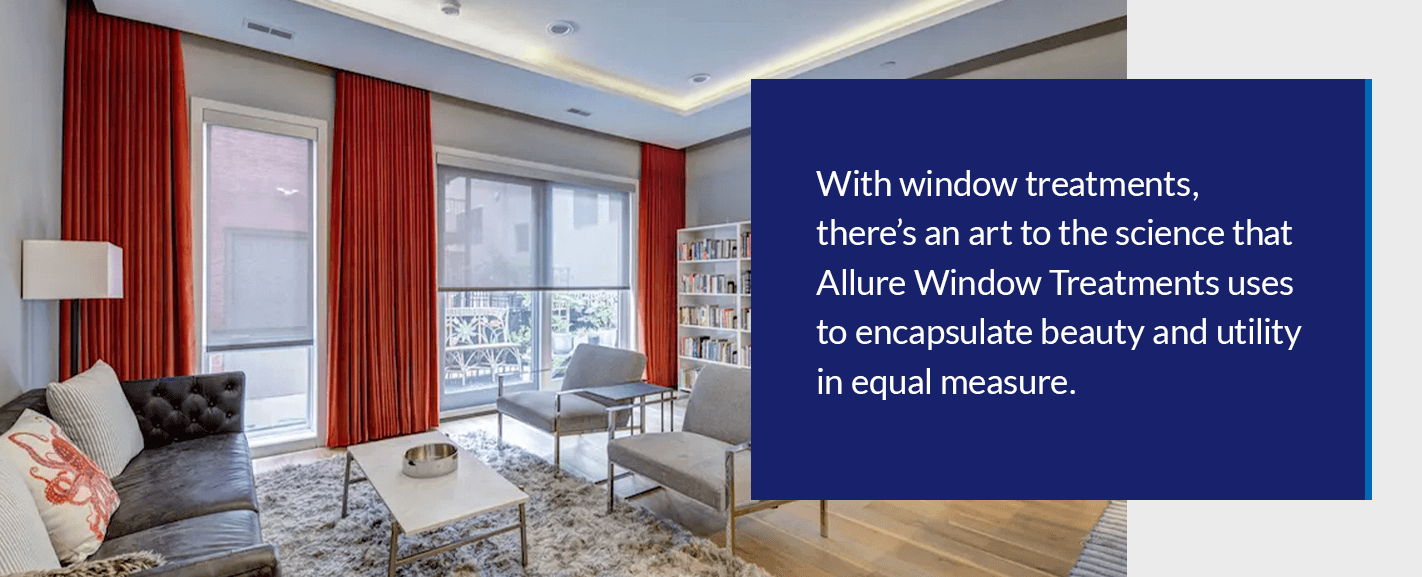How to Measure for Window Blinds, Shades and Curtains
Table of Contents
- Inside Mount vs. Outside Mount
- Tools and Supplies for Measuring Blinds, Shades and Curtains
- How to Measure for Shades
- How to Measure for Blinds
- How to Measure for Curtains
- Minimum Inside-Mounting Clearance for Blinds, Shades and Curtains
- Professional Window Treatment Installation at Allure Window Treatments
Blinds, shades or curtains make a room feel complete. There are endless varieties of window treatments to suit any style. So, the first step to creating functional, appealing window treatments is to take measurements. The standard window length ranges from 36 to 72 inches and the standard width ranges from 24 to 60 inches. However, window sizes and shapes can vary greatly. We’re here to help you get the perfect fit. We’ll show you how to measure your window to get the right-sized blinds or shades, whether your home features modern or traditional styles.
Inside Mount vs. Outside Mount
Before taking any measurements, you need to consider whether you’ll be mounting the window treatment inside or outside the frame. We put together the pros and cons of both installation styles to help you decide.
Inside Mount Pros and Cons
If you’d like to install a window treatment inside the window frame, here are a few reasons to consider an inside mount:
- Creates a clean, elegant look
- Allows you to hang drapes on the outside of the window and blinds or shades inside the window
- Highlights gorgeous window trim or molding
- Suitable for windows that do not have wall space around them
You need to ensure the window has enough depth for the hardware. A window casing should be three inches deep if you wish to mount blinds or curtains inside the window.
Outside Mount Pros and Cons
If your window is not deep enough for an inside mount, your other option is to mount the window treatment outside the window. Here are reasons to consider an outside mount:
- It’s more forgiving and flexible with measurements
- Makes a window appear larger
- An excellent option for blocking out light
Choosing an outside mount conceals the window trim. If you live in an older home with lovely window frames, you may not want to hide the architectural details behind a window treatment.
Tools and Supplies for Measuring Blinds, Shades and Curtains
Elevating your home starts with precise measurements using the following supplies:
- Steel tape measure
- Notepad and pen
- Levels
How to Measure for Shades
It’s important to gauge your window’s dimensions for the following:
- Inside mount shades: Measure the inside width and height to note the narrowest width and shortest heights.
- Inside mount roller and solar shades: Account for the inside width where the brackets will be placed.
- Outside mount shades: Go beyond the window frame, adding width and height.
- Outside mount roller and solar shades: Extend your measurements on each side, typically by 3-4 inches.
Types of Shades
Shades are available for all kinds of window sizes and are excellent at blocking light or making a room more energy-efficient. Here are just a few shade types to consider.
- Roman: Roman shades, made of a continuous piece of fabric, can come in a variety of fabrics from cotton to silk. When rolled up, Roman shades can have the soft, luxurious look of drapery, and when pulled down, they lie flat against the window.
- Honeycomb: This type of shade, also called pleated or cellular shades, pulls down, but the fabric has chambers that trap air, providing greater insulation and possible savings on your home’s energy bill.
- Silhouette: Resembling horizontal blinds in functionality, silhouette shades are s-shaped and made from sheer fabrics that look floating in your windows suspended between light and air. These shades give your windows and your space a sophisticated feel.
- Pirouette: A totally unique experience in window treatments, these shades move and curve upward like a pirouette — their shape gives you elegance with all sun and UV-protection traditional coverings offer. You can have both delightful styles with protection and practical function, which makes these shades desirable in many Philadelphia homes for all types of windows.
- Woven: Woven shades give you the warm feel and strength of nature all in one window dressing. Woven shades typically are seen as rollers, roman and in drapery, so the choice is yours when you bring the textures of the outside into your home.
- Solar: Solar shades are similar to sunglasses, allowing you to see the outside world through the fabric while still providing light control and a clean, modern look.
- Roller: These shades are housed in a valance tube at the top of the window and pull down like a roll of wrapping paper or an old-fashioned school map with a chain or by a motor with a remote control. You get privacy while blocking sun glare and UV rays, but can still see out through the shade.
How to Measure for Blinds
Here is how you can achieve accuracy when measuring blinds:
Inside Mount Blinds
For a clean, built-in look, precise inside frame measurements are crucial.
- Horizontal blinds: Measure width and height in the top, center and bottom.
- Vertical blinds for patio doors and French doors: Account for the entire window opening, measuring each glass panel.
- Windows with molding or trim: Include the trim in your measurements.
Outside Mount Blinds
Here is how to ensure an outside mount will cover more than just the window:
- Horizontal blinds: Add at least 3 inches to the width and height to ensure adequate overlap.
- Vertical blinds for patio doors and French doors: Measure the height from above the window to the floor for full coverage.
- Windows with molding or trim: Measure from the outer edges of the trim for a unified look.
Types of Blinds
There are a variety of types of blinds to choose from. Some blinds to consider include the following.
- Wood: Blinds crafted from genuine hardwoods add warmth, richness and natural beauty to a space. Wood blinds pair gorgeously with other furniture pieces, whether your style is sleek and modern or classic and cozy.
- Aluminum: Contemporary and clean aluminum blinds are ideal in kitchens, bathrooms or laundry rooms.
- Vertical: Vertical blinds are perfect for large floor-to-ceiling windows commonly found in high-rise apartments or spacious lofts and are available in a range of stunning colors, patterns and materials.
- Horizontal: Offer functionality while adding overall aesthetic appeal. They often work well in bedrooms and over-the-sink kitchen windows.
How to Measure for Curtains
Curtains are one of the best ways to complement your home’s interior design and make a space comfortable and inviting. You have limitless options for choosing a curtain color, pattern and fabric. Curtains pair well with inside-mount blinds or shades for a complete window treatment with versatility and style.
As with any window treatment, you’ll want to take measurements before you buy curtains. You’ll also want to decide if you wish to mount the curtains inside or outside the window. The most common way to mount curtains is to do so outside the window frame using a curtain rod. Inside-mount curtains are less popular but might be the better option if the window is deep enough and if there is a lack of wall space around the window.
To measure for curtains, take these steps.
- Determine rod length: Usually, curtain rods extend two to six inches beyond the window frame. This extra length makes a window appear larger and widens the view. It’s ultimately up to you and how much space you want to push the curtains to the side.
- Measure width: If you are hanging curtains outside the window, measure the width of the area you want to cover from one side to the next. Add an inch to the measurement to fully cover the window. If you’re mounting curtains inside the window, measure from one side of the window casing to the next and plan on getting an expandable curtain rod to ensure a tight fit. As a general rule, you’ll want to choose curtains that are at least twice the width of the window.
- Measure length: Measure from the curtain rod to where you want the curtains to hang. You might want the curtains to hang just below the sill or down to the floor — it’s up to you. The goal is to measure the area you want the curtains to cover.
Curtains and drapes also can be lined or unlined. Lined curtains can offer “blackout” capabilities, blocking out all sunlight from the windows, which often makes them perfect for bedrooms. Unlined curtains can work well on windows that usually get lots of shade or you if you have another window treatment, such as blinds, behind the drapes. If the windows receive lots of bright sunlight, a lined curtain protects the room-facing fabric from fading.
Minimum Inside-Mounting Clearance for Blinds, Shades and Curtains
Crafting ambiance begins with meticulous measurements for width and height. Each shade or blind mandates a minimum allowance to nestle neatly inside the window frame. With window treatments, there’s an art to the science that Allure Window Treatments uses to encapsulate beauty and utility in equal measure.
Professional Window Treatment Installation at Allure Window Treatments
Window frames are not standardized and must be measured exactly, especially if you have unique or oddly-sized windows. Hiring a professional to consult with and install your window treatments means the final result will fit exactly to your windows and specifications. Window treatments with advanced features like motorized opening and closing can be more complicated to install, but an experienced professional can easily handle this type of job. A consultant is knowledgeable about all the types of window treatments available and can offer advice on everything from style and color to more technical aspects of each treatment.
Allure Is Here to Help
Allure Window Treatments serves both homes and businesses in the Philadelphia area. As a full-service window treatment design studio, we offer free in-house consultations, professional installation and the highest quality custom window treatments. We guide you through every step of the process.
At Allure, our drapery is custom-made by hand, in house and made to fit your windows — and your style — perfectly. We also install motorized systems for drapes, shades, blinds and more. Our experienced technicians can even integrate them into your existing smart home system, or connect to your tablet or smartphone for ease of use.
Selecting curtains, blinds or shades that produce the desired look requires precise measurements. You may need custom-made blinds or curtains depending on your window shape, size or style. At Allure Window Treatments, we can help you ensure you get the right size for your blinds, shades and curtains, book your free in-home consultation today.

Shani is the Marketing Director of Allure Window Treatments. She has over a decade of experience in the home improvement and window treatments industry.




Sorry, the comment form is closed at this time.